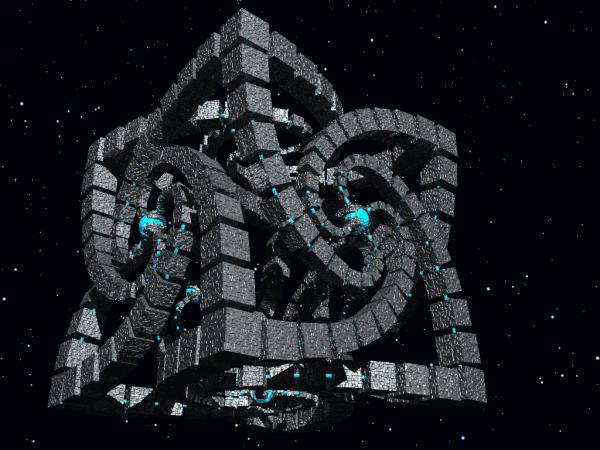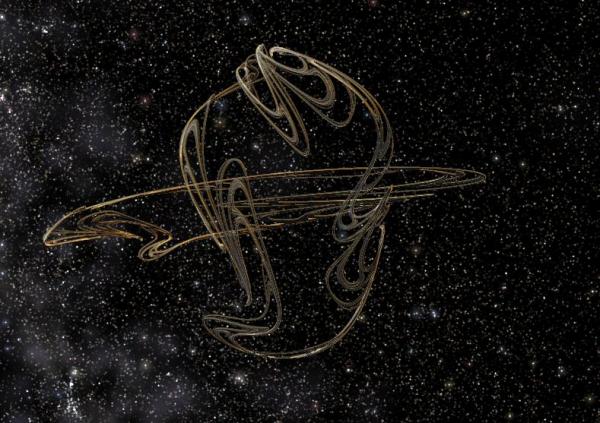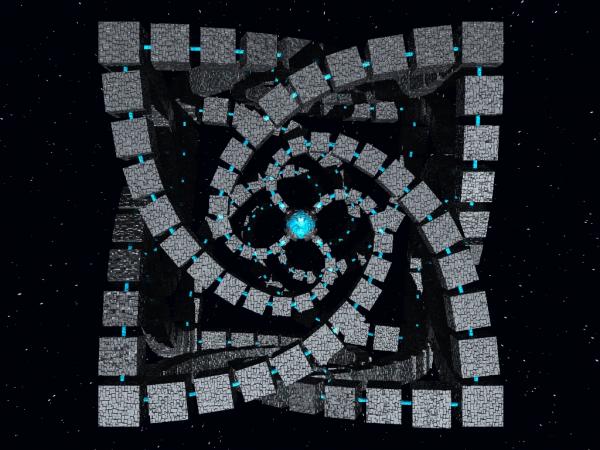
Image from Chris Shaeffer
| |
| The Hemel Deur, a famous Transcension Maze | |
The majority of transcension mazes take the form of large arcology structures or space habitats and are designed to assist the user in ascending from their existing toposophic level to the level above. However, a few mazes are much larger constructions (up to near solar system scale) and offer the seeker the opportunity to ascend through two or more levels, assuming that they are willing to dedicate the time required. The world of Path in the Sophic League offers users the option of ascension to the Second Singularity, while the Transcension Hyperline topopoli and the Strange Attractors in the Keter Dominion offer ascension to the Third singularity, each by different paths.

Image from Steve Bowers
| |
| A Strange Attractor transcension maze in the Keter Dominion | |
When a user travels through a transcension maze, they are exposed to a series of tests, exercises, and augmentation procedures that gradually increase their mental and physical capabilities until they are finally able to make the leap to the next highest toposophic level. During the course of their journey through the maze, the structure employs a combination of nanotech, biotech, and occasionally godtech technologies to provide sustenance and compatible environments for each user so that they do not need to leave the maze or concern themselves with anything other than the goal of ascending to the next toposophic. The resources for these technologies are generally extracted from the local planetary or solar environment by automated systems associated with the maze (the Transcension Hyperline topopoli employ stellar extraction and deep well technologies to mine the local star for raw materials) although in the NoCoZo several mazes require the user to provide the raw materials for their transcension as a condition for entrance into the maze.

Image from Chris Shaeffer
| |
| The Hemel Deur from 'above' | |
Finally, a number of virtual transcension mazes have been created in the last several millennia. Readily accessible across the Known Net and easily downloaded into a modest sized processing core these software devices offer users the option of attempting to transcend without the need to travel to the location of a physical maze (although significant life support and nanoconstruction resources are required for most such applications). The Irali Overcode Environment is one of the more well-known virtual transcension mazes extant in the Terragen Sphere today.
Arcology
RépondreSupprimerTerm coined by the visionary Atomic Age Old Earth architect Paolo Soleri in 10 BT (1959 c.e.) to describe the concept of Architecture and Ecology working as an integral system.
The result is a planned, building/neighborhood/city that is integrated into the landscape and enables the inhabitants to live holistic lives, integrating work and play. Arcology designs are fully 3-dimensional, mega-structure cities which can in theory achieve much greater efficiencies, and promote more social interaction than 2-dimensional cities, while using far less land and consuming fewer resources.
Soleri's movement lured a community of architecture students to Arcosanti, Arizona, USA to study, but the movement fell apart during the middle Information Age. The arcology meme however had already been established in popular fiction (especially cyberpunk rpging and early virch) as a gigantic, more-or-less self-contained building /community, usually with businesses and industries built in, a city-in-a-building, with the implication of the various sociopolitical consequences thereof. Such corporate arcologies of popular fiction were seen as the places where sinister forces and their minions did their work.
Especially during the early to middle Interplanetary age, Arcologies did connote isolation and exclusiveness, but this was less because of any prophetic post-apocalyptic literature and more because one already needed wealth and connections to live in the luxurious and safe apartments that these communities offered. During the nanotech period the tables were turned, and arcolgans found themselves locked out of the resources of the countryside that provided raw materials for the nanite craze. However, the ai-controlled and blue-goo shielded nature of the arcologies meant that their inhabitants had the best chances during the nano-plagues and nano-swarm years, and most survived without mishap (in contrast, the country- and suburban-dwellers suffered very high casualty rates)
RépondreSupprimerBecause of the extreme restrictions on space and resources that go along with inhabiting garden worlds and even terraformed previously hostile planets, the arcology model has indeed turned out to be the most optimal one for planetside communities. Apart from out in the Periphery and on some newly terraformed worlds, almost all planetside cities are arcological or quasi-arcological in nature. Often even on closed environment colonies, a large habitat dome will include one or two arcologies among a garden-like biospheric setting. Arcologies are also popular on high density orbitals, where they enable maximum population densities with minimum resource demand.
Ironically, the arcology meme has come full circle - from a place for the secluded and elite technosavvy upper-middle class it has become a lifestyle setting for those without wealth or resources to own or live in their own habitat or planetary wide surface.